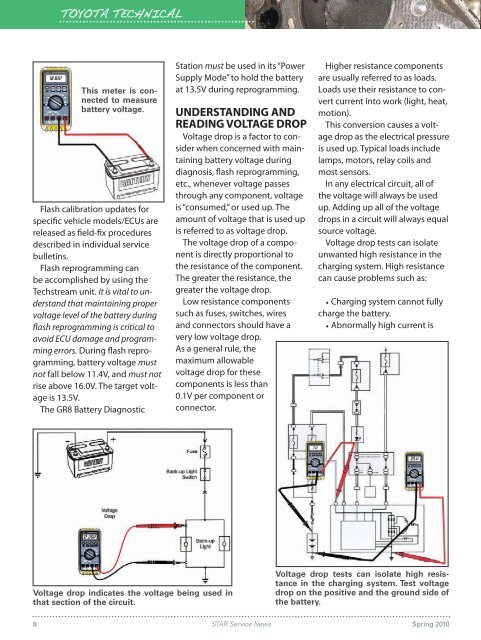STAR Service News Missed an issue? - Toyota Parts & Service
STAR Service News Missed an issue? - Toyota Parts & Service
STAR Service News Missed an issue? - Toyota Parts & Service
You also want an ePaper? Increase the reach of your titles
YUMPU automatically turns print PDFs into web optimized ePapers that Google loves.
TOYOTA TECHNICAL<br />
This meter is connected<br />
to measure<br />
battery voltage.<br />
Flash calibration updates for<br />
specifi c vehicle models/ECUs are<br />
released as fi eld-fi x procedures<br />
described in individual service<br />
bulletins.<br />
Flash reprogramming c<strong>an</strong><br />
be accomplished by using the<br />
Techstream unit. It is vital to underst<strong>an</strong>d<br />
that maintaining proper<br />
voltage level of the battery during<br />
fl ash reprogramming is critical to<br />
avoid ECU damage <strong>an</strong>d programming<br />
errors. During fl ash reprogramming,<br />
battery voltage must<br />
not fall below 11.4V, <strong>an</strong>d must not<br />
rise above 16.0V. The target voltage<br />
is 13.5V.<br />
The GR8 Battery Diagnostic<br />
Voltage drop indicates the voltage being used in<br />
that section of the circuit.<br />
Station must be used in its “Power<br />
Supply Mode” to hold the battery<br />
at 13.5V during reprogramming.<br />
UNDERSTANDING AND<br />
READING VOLTAGE DROP<br />
Voltage drop is a factor to consider<br />
when concerned with maintaining<br />
battery voltage during<br />
diagnosis, fl ash reprogramming,<br />
etc., whenever voltage passes<br />
through <strong>an</strong>y component, voltage<br />
is “consumed,” or used up. The<br />
amount of voltage that is used up<br />
is referred to as voltage drop.<br />
The voltage drop of a component<br />
is directly proportional to<br />
the resist<strong>an</strong>ce of the component.<br />
The greater the resist<strong>an</strong>ce, the<br />
greater the voltage drop.<br />
Low resist<strong>an</strong>ce components<br />
such as fuses, switches, wires<br />
<strong>an</strong>d connectors should have a<br />
very low voltage drop.<br />
As a general rule, the<br />
maximum allowable<br />
voltage drop for these<br />
components is less th<strong>an</strong><br />
0.1V per component or<br />
connector.<br />
Higher resist<strong>an</strong>ce components<br />
are usually referred to as loads.<br />
Loads use their resist<strong>an</strong>ce to convert<br />
current into work (light, heat,<br />
motion).<br />
This conversion causes a voltage<br />
drop as the electrical pressure<br />
is used up. Typical loads include<br />
lamps, motors, relay coils <strong>an</strong>d<br />
most sensors.<br />
In <strong>an</strong>y electrical circuit, all of<br />
the voltage will always be used<br />
up. Adding up all of the voltage<br />
drops in a circuit will always equal<br />
source voltage.<br />
Voltage drop tests c<strong>an</strong> isolate<br />
unw<strong>an</strong>ted high resist<strong>an</strong>ce in the<br />
charging system. High resist<strong>an</strong>ce<br />
c<strong>an</strong> cause problems such as:<br />
• Charging system c<strong>an</strong>not fully<br />
charge the battery.<br />
• Abnormally high current is<br />
Voltage drop tests c<strong>an</strong> isolate high resist<strong>an</strong>ce<br />
in the charging system. Test voltage<br />
drop on the positive <strong>an</strong>d the ground side of<br />
the battery.<br />
8 <strong>STAR</strong> <strong>Service</strong> <strong>News</strong><br />
Spring 2010










